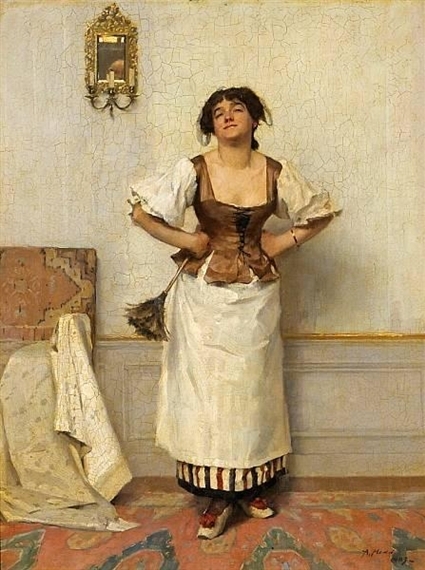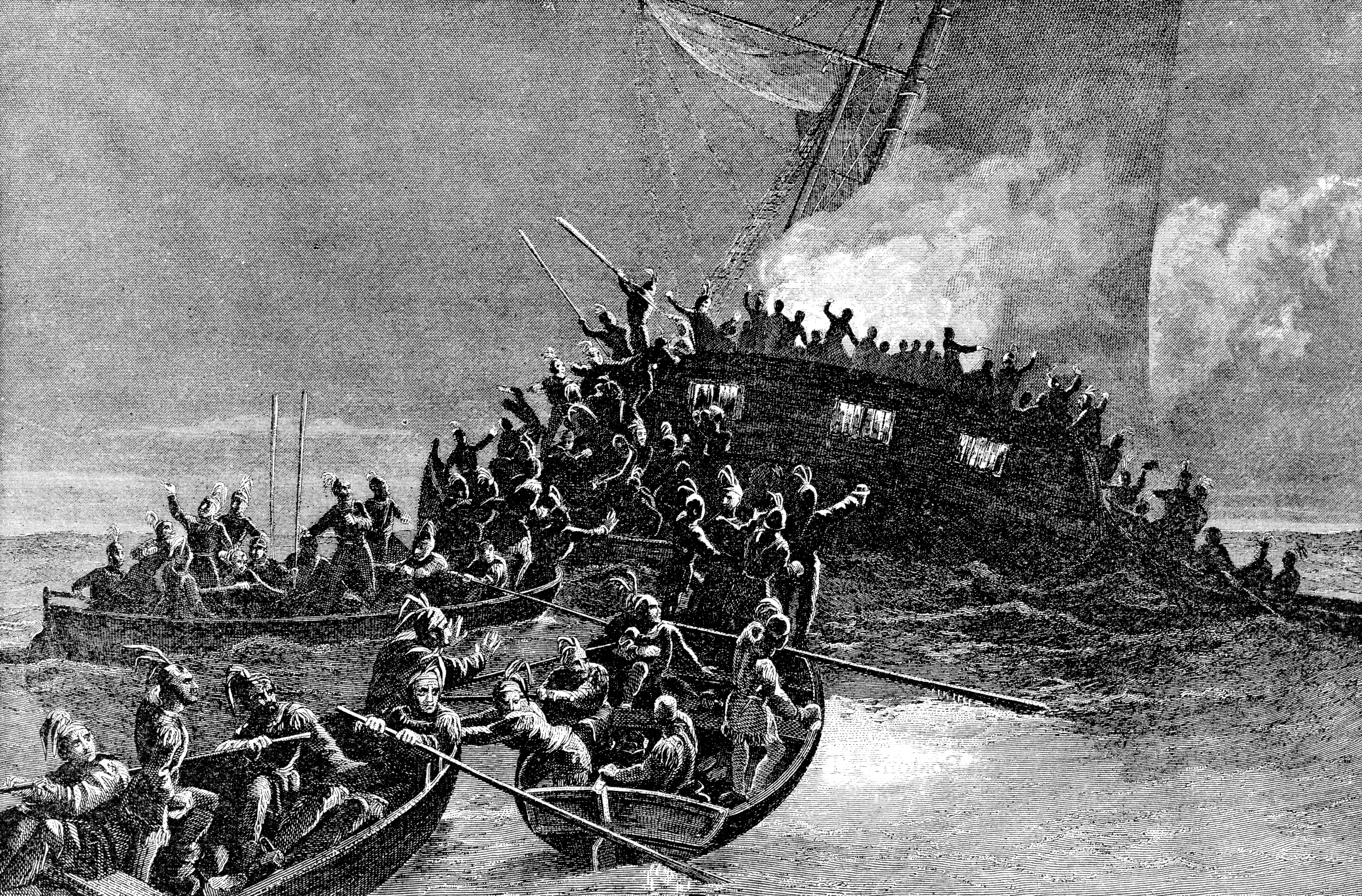|
Louise Götz
Louise Götz (1772-?), was a Swedish stage actress. She belonged to the elite of the pioneer generation actors of the Royal Dramatic Theatre (1788-1805). She was the daughter of Louis Götz, who was a wig maker of the Royal Swedish Opera. She married Gabriel Saint-Remy, a servant of the royal court, and was thus known as Louise Saint-Remy until her divorce, when she called herself Mrs Götz. As many other of the pioneer generation of actors at the Royal Dramatic Theatre, Louise Götz was engaged as an actress at the theater of Adolf Fredrik Ristell, which was founded in 1787, and transferred to the staff of the Royal Dramatic Theatre when the Ristell theatre when bankrupt and was transformed to the Royal Dramatic Theatre, which was founded in 1788. Louise Götz belonged to the more famed of the actors of the theater. Described as pretty and sensual, she was hugely popular in soubrette- and breeches roles and received one of the highest salaries of the theater.Nordensvan, Geor ... [...More Info...] [...Related Items...] OR: [Wikipedia] [Google] [Baidu] |
Royal Dramatic Theatre
The Royal Dramatic Theatre (, colloquially ''Dramaten'') is Sweden's national stage for "spoken drama", founded in 1788. Around one thousand shows are put on annually on the theatre's five running stages. The theatre has been at its present location in the Art Nouveau building at Nybroplan, Stockholm, since 1908. The theatre was built by the architect Fredrik Lilljekvist. Famous artists like Carl Milles and Carl Larsson were involved in making the decorations, and some of the interior decorations were made by Prince Eugen. The theatre's acting school, the Royal Dramatic Training Academy, produced many actors and directors who would go on to be famous, including Gustaf Molander (who also taught there), Alf Sjöberg, Greta Garbo, Vera Schmiterlöw, Signe Hasso, Ingrid Bergman, Gunnar Björnstrand, Max von Sydow, and Bibi Andersson. The school was split off as a separate institution in 1967 (see Swedish National Academy of Mime and Acting). History 17th and 18th ce ... [...More Info...] [...Related Items...] OR: [Wikipedia] [Google] [Baidu] |
Royal Swedish Opera
Royal Swedish Opera () is an opera and ballet company based in Stockholm, Sweden. Location and environment The building is located in the centre of Sweden's capital, Stockholm, in the borough of Norrmalm (borough), Norrmalm, on the eastern side of Gustav Adolfs torg, Stockholm, Gustav Adolfs torg across from the former Arvfurstens Palats, now the Ministry for Foreign Affairs (Sweden), Ministry for Foreign Affairs. It lies on the north side of the Norrström River and is connected to the Stockholm Palace, Royal Palace through the Norrbro Bridge. Other historically and architecturally important buildings in the close neighbourhood are the Sager House, the official residence of the Prime Minister of Sweden, and the Riksdag building. History The opera company was founded with the Royal Swedish Academy of Music by King Gustav III of Sweden, Gustav III, and its first performance, ''Thetis and Phelée'' with Carl Stenborg and Elisabeth Olin, was given on 18 January 1773; this was th ... [...More Info...] [...Related Items...] OR: [Wikipedia] [Google] [Baidu] |
Adolf Fredrik Ristell
Adolf (also spelt Adolph or Adolphe, Adolfo, and when Latinised Adolphus) is a given name with German origins. The name is a compound derived from the Old High German ''Athalwolf'' (or ''Hadulf''), a composition of ''athal'', or ''adal'', meaning "noble" (or '' had(u)''-, meaning "battle, combat"), and ''wolf''. The name is cognate to the Anglo-Saxon name '' Æthelwulf'' (also Eadulf or Eadwulf). The name can also be derived from the ancient Germanic elements "Wald" meaning "power", "brightness" and wolf (Waldwulf). Due to its extremely negative associations with the Nazi leader Adolf Hitler, the name has greatly declined in popularity since the end of World War II. Similar names include Lithuanian Adolfas and Latvian Ādolfs. The female forms Adolphine and Adolpha are far more rare than the male names. Adolphus can also appear as a surname, as in John Adolphus, the English historian. Popularity and usage During the 19th and early 20th centuries, Adolf was a popular name for ... [...More Info...] [...Related Items...] OR: [Wikipedia] [Google] [Baidu] |
Soubrette
A soubrette is a female minor stock character in opera and theatre, often a pert lady's maid. By extension, the term can refer generally to any saucy or flirtatious young woman. The term arrived in English from Provençal via French, and means "conceited" or "coy". Theatre In theatre, a soubrette is a comedy character who is vain and girlish, mischievous, lighthearted, coquettish and gossipy—often a chambermaid or confidante of the ingénue. She often displays a flirtatious or even sexually aggressive nature. The soubrette appeared in commedia dell'arte scenarios, often in the role of Columbina, where the actress would provide the details of her behaviour and dialogue. From there, she moved to the works of Molière, which were influenced by the Commedia; the role of Dorine in '' Tartuffe'' (1664) fits the description. A famous example, though a hundred years later, is Suzanne in Beaumarchais' '' Le Mariage de Figaro'' (1784). Opera In classical music and opera, the term ''s ... [...More Info...] [...Related Items...] OR: [Wikipedia] [Google] [Baidu] |
Breeches Role
In theater, a breeches role or breeches part (also pants role, pants part, trouser role, trouser part, and Hosenrolle) is a role in which a female actor performs in male clothing. Breeches, tight-fitting knee-length pants, were a standard male garment when these roles were introduced. The theatrical term '' travesti'' covers both this sort of cross-dressing and also male actors dressing as female characters. Both are part of the long history of cross-dressing in music and opera and later in film and television. In opera, a breeches role refers to any male character that is sung and acted by a female singer. Most often the character is an adolescent or a very young man, sung by a mezzo-soprano or contralto. Budden J., "Breeches part" in: '' The New Grove Dictionary of Opera''. Macmillan, London and New York, 1997. The operatic concept assumes that the character is male, and the audience accepts him as such, even knowing that the actor is not. Cross-dressing female characters ( ... [...More Info...] [...Related Items...] OR: [Wikipedia] [Google] [Baidu] |
Gustav IV Adolf Of Sweden
Gustav IV Adolf or Gustav IV Adolph (1 November 1778 – 7 February 1837) was List of Swedish monarchs, King of Sweden from 1792 until he Coup of 1809, was deposed in a coup in 1809. He was also the last Swedish monarch to be the ruler of Finland. The occupation of Finland in 1808–09 by Russian forces was the immediate cause of Gustav Adolf's overthrow, violently initiated by officers of his own army. Following his abdication on 29 March 1809, an Instrument of Government (1809), Instrument of Government was hastily written, which severely circumscribed the powers of the monarchy. The "Instrument" was adopted in 1809 on 6 June, the National Day of Sweden now as well as in his time. It remained in force until replaced in 1974. The crown, now with strictly limited powers, passed to Gustav Adolf's uncle Charles XIII., ch. 37, pp. 203–219. Early life Gustav Adolf was born in Stockholm on 1 November 1778 as the son of Gustav III and queen Sophia Magdalena of Denmark, Sophia M ... [...More Info...] [...Related Items...] OR: [Wikipedia] [Google] [Baidu] |
1772 Births
Events January–March * January 10 – Shah Alam II, the Mughal Emperor of India, makes a triumphant return to Delhi 15 years after having been forced to flee. * January 17 – Johann Friedrich Struensee and Queen Caroline Matilda are arrested, leading to his execution and her banishment from Denmark. * February 12 ** Breton-French explorer Yves-Joseph de Kerguelen-Trémarec discovers the uninhabited Kerguelen Islands in the Southern Indian Ocean. ** The Virginia Assembly amends an act to describe the punishments for the practice of gouging. * February 17 – The First Partition of Poland is agreed to by Russia and Prussia, later including Austria. * March 8 – Biela's Comet is first discovered by French astronomer Jacques Leibax Montaigne, but not proven to be a periodic comet until 1826, when Wilhelm von Biela correctly identifies its return. * March 20 – Pedro Fages, the Spanish Governor of Alta California, and Juan Crespí, a Cath ... [...More Info...] [...Related Items...] OR: [Wikipedia] [Google] [Baidu] |
Year Of Death Unknown
A year is a unit of time based on how long it takes the Earth to orbit the Sun. In scientific use, the tropical year (approximately 365 solar days, 5 hours, 48 minutes, 45 seconds) and the sidereal year (about 20 minutes longer) are more exact. The modern calendar year, as reckoned according to the Gregorian calendar, approximates the tropical year by using a system of leap years. The term 'year' is also used to indicate other periods of roughly similar duration, such as the lunar year (a roughly 354-day cycle of twelve of the Moon's phasessee lunar calendar), as well as periods loosely associated with the calendar or astronomical year, such as the seasonal year, the fiscal year, the academic year, etc. Due to the Earth's axial tilt, the course of a year sees the passing of the seasons, marked by changes in weather, the hours of daylight, and, consequently, vegetation and soil fertility. In temperate and subpolar regions around the planet, four seasons ar ... [...More Info...] [...Related Items...] OR: [Wikipedia] [Google] [Baidu] |
18th-century Swedish Actresses
The 18th century lasted from 1 January 1701 (represented by the Roman numerals MDCCI) to 31 December 1800 (MDCCC). During the 18th century, elements of Enlightenment thinking culminated in the Atlantic Revolutions. Revolutions began to challenge the legitimacy of monarchical and aristocratic power structures. The Industrial Revolution began mid-century, leading to radical changes in human society and the environment. The European colonization of the Americas and other parts of the world intensified and associated mass migrations of people grew in size as part of the Age of Sail. During the century, slave trading expanded across the shores of the Atlantic Ocean, while declining in Russia and China. Western historians have occasionally defined the 18th century otherwise for the purposes of their work. For example, the "short" 18th century may be defined as 1715–1789, denoting the period of time between the death of Louis XIV of France and the start of the French Revolution, ... [...More Info...] [...Related Items...] OR: [Wikipedia] [Google] [Baidu] |
19th-century Swedish Actresses
The 19th century began on 1 January 1801 (represented by the Roman numerals MDCCCI), and ended on 31 December 1900 (MCM). It was the 9th century of the 2nd millennium. It was characterized by vast social upheaval. Slavery was abolished in much of Europe and the Americas. The First Industrial Revolution, though it began in the late 18th century, expanded beyond its British homeland for the first time during the 19th century, particularly remaking the economies and societies of the Low Countries, France, the Rhineland, Northern Italy, and the Northeastern United States. A few decades later, the Second Industrial Revolution led to ever more massive urbanization and much higher levels of productivity, profit, and prosperity, a pattern that continued into the 20th century. The Catholic Church, in response to the growing influence and power of modernism, secularism and materialism, formed the First Vatican Council in the late 19th century to deal with such problems and confirm cer ... [...More Info...] [...Related Items...] OR: [Wikipedia] [Google] [Baidu] |






